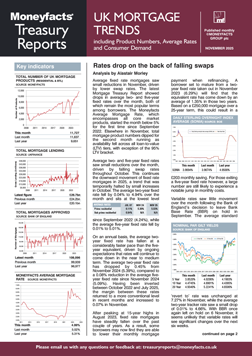Rachel Springall, Finance Expert at Moneyfacts, said:
“Borrowers may well be disappointed to see fixed mortgage rates on the rise. Volatile swap rates and a cautionary approach among lenders have led to an abrupt halt in consecutive monthly average rate falls. The average two- and five-year fixed mortgage rates rose by 0.02%, to 4.98% and 5.02% respectively, the first month-on-month rise in eight months (February 2025). Overall, the Moneyfacts Average Mortgage Rate also rose for the first time since February 2025 to 5.02%. The shift in sentiment towards pre-pricing and product churn during September led to a rise in the average shelf-life of a mortgage, to 22 days, the first jump above 20 days for six months (21 days – April 2025). This increase is likely a result of a calming mortgage market, so it will be interesting to see if activity picks up should lenders need to hit any year-end targets.
“There may be little margin of rate movement from lenders in the coming weeks, prolonging the subdued sentiment. Inflation is expected to peak at 4%, which would then be double the desired 2% target, so any imminent base rate cuts by the Bank of England seem unlikely. However, even with the three base rate cuts since the start of 2025, fixed mortgage rates can move up regardless, such as in reaction to volatile swap rates. It is not all doom and gloom for borrowers, as the mortgage market has shown how far it has improved over recent years. Borrowers who locked into a two-year fixed rate deal back in October 2023 would have been paying 6.47% in interest on average, compared to 4.98% now. That is a difference of £225 per month in repayments on a £250,000 mortgage over 25 years.
“The repercussions of rising fixed rates and subdued sentiment stifle the Government’s push for lenders to do more to boost UK growth. However, even with a slight dip in product choice across the mortgage spectrum, the combined quantity of deals available to borrowers with a 5% or 10% deposit or equity stands at a 17-year high. The relaxation of loan-to-income rules is a positive step for improving mortgage affordability challenges, but first-time buyers are still waiting for more affordable housing to be built. Whether purchasing or refinancing, it remains essential borrowers seek independent advice to navigate the mortgage maze and not feel pressured to secure a deal because of the Budget rumour mill.”
Rachel Springall, Finance Expert at Moneyfacts, said:
“Borrowers may well be disappointed to see fixed mortgage rates on the rise. Volatile swap rates and a cautionary approach among lenders have led to an abrupt halt in consecutive monthly average rate falls. The average two- and five-year fixed mortgage rates rose by 0.02%, to 4.98% and 5.02% respectively, the first month-on-month rise in eight months (February 2025). Overall, the Moneyfacts Average Mortgage Rate also rose for the first time since February 2025 to 5.02%. The shift in sentiment towards pre-pricing and product churn during September led to a rise in the average shelf-life of a mortgage, to 22 days, the first jump above 20 days for six months (21 days – April 2025). This increase is likely a result of a calming mortgage market, so it will be interesting to see if activity picks up should lenders need to hit any year-end targets.
“There may be little margin of rate movement from lenders in the coming weeks, prolonging the subdued sentiment. Inflation is expected to peak at 4%, which would then be double the desired 2% target, so any imminent base rate cuts by the Bank of England seem unlikely. However, even with the three base rate cuts since the start of 2025, fixed mortgage rates can move up regardless, such as in reaction to volatile swap rates. It is not all doom and gloom for borrowers, as the mortgage market has shown how far it has improved over recent years. Borrowers who locked into a two-year fixed rate deal back in October 2023 would have been paying 6.47% in interest on average, compared to 4.98% now. That is a difference of £225 per month in repayments on a £250,000 mortgage over 25 years.
“The repercussions of rising fixed rates and subdued sentiment stifle the Government’s push for lenders to do more to boost UK growth. However, even with a slight dip in product choice across the mortgage spectrum, the combined quantity of deals available to borrowers with a 5% or 10% deposit or equity stands at a 17-year high. The relaxation of loan-to-income rules is a positive step for improving mortgage affordability challenges, but first-time buyers are still waiting for more affordable housing to be built. Whether purchasing or refinancing, it remains essential borrowers seek independent advice to navigate the mortgage maze and not feel pressured to secure a deal because of the Budget rumour mill.”









